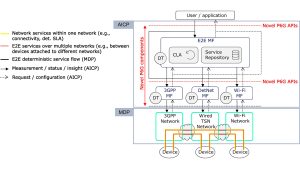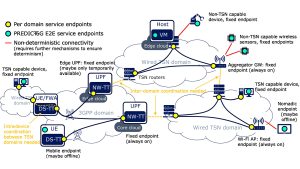Integrating a large number of communication technologies could promote remote control of precision robots.
Despite its undeniable utility, communication networks are known to experience latency and sometimes fail, which makes them less reliable for use cases with zero resistance to failure. Predict-6G leverages the synergy of Ethernet, cellular, and WiFi, and connects them through logic overlays to create a reliable and decisive network that can provide time-sensitive network (TSN) services. The latter includes the connectivity industry, which allows remote control of devices on factory floors, improves operational health and safety, and reduces OPEX through centralized command and control.
The key to the Predict-6 G value proposition is the creation of a multi-domain multi-tech data plane (MDP) and an artificial intelligence (AI)-driven control plane (AICP). MDP provides a physical infrastructure that stitches together access technologies to ensure end-to-end packet delivery.
Access technology is similar to transportation systems with different levels of reliability. Wiring TSN can be considered rail transport with dedicated routes, WiFi is a road network in the country with no traffic lights, and cellular 3GPP network is a well-regulated road network with traffic lights at every intersection. Currently, the main purpose of Predict-6G can be thought of as delivering important items such as kidneys, from remote donors to far-reaching hospitals, for transplants scheduled just in time with all these different systems.

It is all about deterministic networking to ensure that this delivery is always on time and arrives regardless of which network moves. That means ensuring timing and reliability, such as knowing exactly when the train will arrive or that your important parcel will not get lost or delayed unexpectedly.
The goal is to create seamless and predictable paths for critical data across these mixed networks. Packet delivery must be adjusted to ensure that there is no delay introduced at the intersection of different communication technologies.
MDP
The predictive 6G architecture shown in Figure 1 utilizes IETF Deterministic Networking (DetNet) as a kind of universal translator or management layer over these different communication networks. Detnet acts as an “Express Service” overlay. Our analogy manages how higher priority “deterministic” packets move them, rather than replacing road and train trucks. To ensure that timing and reliability needs are met.
Therefore, each technology must adapt to meet these requirements.
Wired TSN
Wired TSNs are already designed for deterministic traffic. Use standards such as IEEE 802.1QBV for priority scheduling for multiple traffic types and 802.1AS for synchronization. Additionally, frame duplication and elimination for reliability (FRER) sends multiple copies of the packet to ensure delivery (the receiver removes duplicates).
Wifi
WiFi is less predictable given the many WiFi enabled devices that share channels. To enable determinism, Predict-6G adopts several enhancements. The first of these is a limited target wake time (RTWT reduces channel usage as it is a feature that allows devices to wake up and sleep at different times). Similarly, time synchronization aligns the wake period with the send and receive cycles. The third important enhancement is to reduce unpredictable delays for normal random access, as it is channel access scheduling.
3GPP
3GPP is also the best efficiency network and requires adjustment to enable determinism. These keys are to keep latency low and consistent with careful resource allocation of radio resources and traffic scheduling. Secondly, special components called TSN-Translators (DS-TT and NW-TT) are at the edge of a 3GPP network, so 3GPP acts as a TSN switch and allows for smooth connections with other TSN-enabled networks. Finally, adapting the signal quality settings (carefully selecting the number of bits per symbol sent) avoids errors and retransmissions that cause delays. Additionally, adaptive removal techniques reduce variations in packet arrival times.
IETF DETNET
This is the layer that brings together these different communication technologies. Devices or nodes at network intersections (such as gateways and routers) have additional dead net capabilities. One such function is “forward”. This involves sending packets along the correct path. Encapsulation and deencapsulation involves enclosing deterministic data packets inside another packet (such as placing letters in a special express envelope) when they enter the dead net portion of the network and extracting them when they leave. This is often done using methods such as MPLS tagging and UDP/IP tunneling. The third important function is the Packet Replication, Elimination, and Ordering Functions (PREOF). This adds robustness by sending multiple copies of packets over different paths for reliability, discarding the arrival (excluded) range, ensuring that the packet is delivered in the correct sequence. This helps smooth out delivery and reduce “jitter” (variation in delay).

This multi-network integration has been successfully tested in a real lab setup using commercially available equipment. This indicates that it is possible to work together to provide end-to-end deterministic services.
Additionally, by adding an MDP agent to provide the required deterministic functionality at the top, this system can include networks or devices that do not have built-in deterministic functionality.
AICP
AICP is a smart central management system located above MDP. Its main goal is to manage these different networks in a unified way to provide guaranteed end-to-end deterministic services.
AICP is hierarchical. On the other hand, a local management domain (MD) manages only one type of network technology (such as a WiFi network or a 3GPP network). On the other hand, the end-to-end (E2E) management domain is responsible for overseeing the entire route of packets across all different networks.
AICP creates a simplified common view of each network domain. Instead of knowing all the roads or train tracks, at the E2E level, we look at the simplified connections between the main entry and exit points for each network domain (such as “network slices”) and details of the types of express service features the domain offers (such as guaranteed low latency or high reliability). Local MDS helps to provide this simplified view.
Like complex organizations, AICP has different departments, each with a specific job.
Service Intake: acts as a front desk where deterministic service requests (such as sending that important parcel) are received and checked.
Exposure Services: A “department” that collects information from different network domains (topology, available capacity, special features, etc.) and makes this information available to other parts of AICP.
Path calculation: Route planner. The E2E level plans the overall trajectory (sequence of network domains to use), and the local MD level plans specific routes within each network domain.

Resource Contributor: The team that actually sets up the transportation system. It tells you how wired TSN switches, WiFi access points, and 3GPP network functions handle each time sensitive packet, ensuring you get the necessary guaranteed services.
Service Automation: Acts as a project manager who oversees the entire process of setup (provisioning), maintaining, and ultimately shutting down (deprecation) services. Coordinate all other departments. It works in a closed loop and relies on control via algorithms rather than human.
Data Collection and Management (Monitoring): Collect real-time performance data (e.g., if a copy is lost, how much parcel was spent) from all networks.
Time Synchronization: Ensures that all involved devices operate simultaneously across different networks. This is extremely important for time-sensitive traffic.
Additionally, AICP uses AI and machine learning (ML) and uses digital twins (DTS – an inherently detailed virtual model of networks). Digital twins help simulate what-if scenarios and determine whether the network should allow new flows. AI/ML can use collected real-time data and simulations from DTS to make smarter decisions about route planning, resource allocation, and responding quickly when services do not meet guarantees. The MLOPS framework helps you manage these AI tools.
Essentially, AICP is a sophisticated control system that uses hierarchical structures, data abstractions, and AI/ML with digital twins, managing the complexity of providing guaranteed deterministic communication services across diverse network technologies such as wired TSN, WiFi, and 3GPP. Critical data packets will ensure that they arrive on time by intelligently planning, configuring and monitoring end-to-end paths (regardless of the combination of networks they pass through).
What’s coming next
To meet the harsh and critical performance metrics of the emergent vertical use cases of 6G, the capabilities of countless access technologies must be exploited to one advantage and compensate for the weakness of the other. Predict-6G focuses on connected industries and how to remotely control devices such as robots to eliminate the need to place workers on factory floors. The deterministic networking capabilities developed by Predict-6G can be utilized to allow critical services such as remote remote surgery using high-precision surgical robots connected to remote area professionals through countless access technologies. The possibilities are endless.
This article will also be featured in the 23rd edition of Quarterly Publication.
Source link

